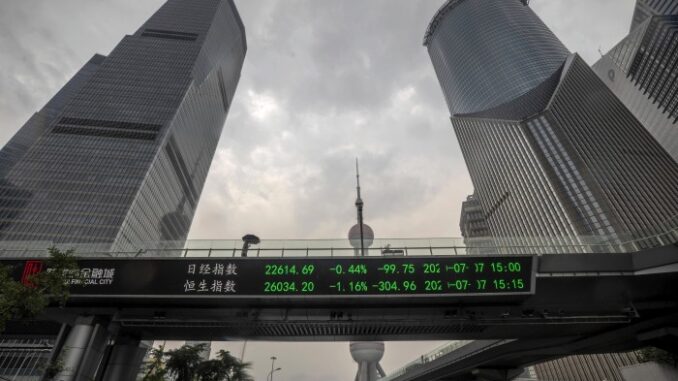
(Bloomberg) — US equity-index futures fell as concern the Federal Reserve will keep borrowing costs higher for longer outweighed optimism over China’s economic recovery.
Contracts on the S&P 500 Index slipped 0.3% as trading was muted amid a US holiday. The Stoxx Europe 600 Index was marginally higher after fluctuating in a tight range throughout the day. The Shanghai Composite Index climbed the most since November. Treasury futures were lower as investors assessed hawkish comments by Federal Reserve officials. The dollar took a breather from a three-week rally.
A chorus of investors including Goldman Sachs Group Inc. is betting on Chinese equities to resume a rally as the world’s second-biggest economy deepens stimulus and relaxes pandemic restrictions. While this has sparked inflows into global assets tied to the Chinese economy, the broader sentiment in markets remains impaired, with the Fed resolute on its fight against inflation. Growing geopolitical tensions are also preventing investors from turning more bullish.
“2023 will be much bumpier than the current performance would suggest,” Luca Fina, head of equities at Generali Insurance Asset Management, wrote in a note. “It would make sense to reduce the cyclicality of portfolios — adding some cheap year-to-date losers that should perform better in a higher-volatility and uncertainty scenario (and) by reducing those who are currently more expensive and pricing a Goldilocks scenario.”
Europe’s Stoxx 600 was little changed, with consumer and technology stocks acting as a drag, even as commodity names rallied. In China, stocks gained after a Goldman report that penciled in a rebound on the back of an earnings recovery. Calls for further stimulus via lower rates also built up, prompting the nation’s banks to keep their lending rates unchanged.
Contracts on the S&P 500 and Nasdaq 100 indexes slipped, with Treasury futures dropping across the curve. Stocks ended last week on a muted note after Richmond Fed President Thomas Barkin and Fed Governor Michelle Bowman both expressed their support for continued rate hikes. That followed hawkish remarks by St. Louis Fed President James Bullard and Cleveland President Loretta.
Given the holiday absence of US traders, it was unclear how the markets viewed the flurry of geopolitical developments over the past few days. First, the weekend underscored growing tensions between the world’s two superpowers: US Secretary of State Antony Blinken and China’s State Councilor Wang Yi traded barbs on everything from Taiwan to North Korea and Russia in their first meeting since a spy balloon controversy. Then, North Korea fired a barrage of suspected ballistic missiles and issued a warning to the US over joint military exercises.
On Monday, US President Joe Biden made a surprise visit to Kyiv and met with his Ukrainian counterpart Volodymyr Zelenskiy, declaring “unwavering support” in a show of solidarity as Russia’s invasion nears the one-year mark.
Oil futures advanced on Monday. Demand from China will climb by 800,000 barrels a day in 2023, according to the median estimate of 11 China-focused consultants surveyed by Bloomberg News. That would take consumption to an all-time high of about 16 million barrels a day, the survey showed.
“The only place where the central bank will remain soft enough is China, to recover from a series of absurd Covid measures that pushed the economy into an unnecessary depressed zone,” Ipek Ozkardeskaya, a senior analyst at Swissquote Bank, wrote in a note.
Investors also awaited clues on US consumer demand as Walmart Inc. and Home Depot Inc. were set to kick off a slew of retail earnings reports this week.
Source: ca.finance.yahoo.com



